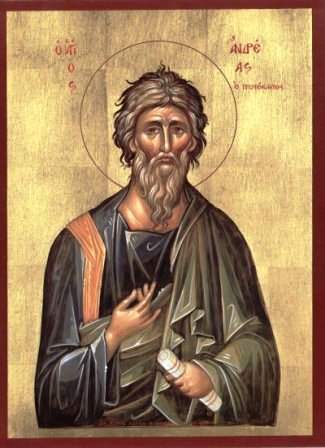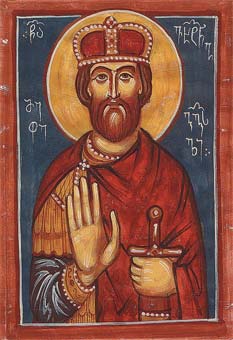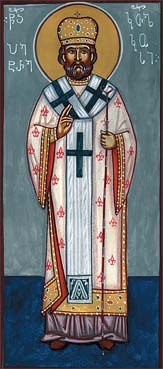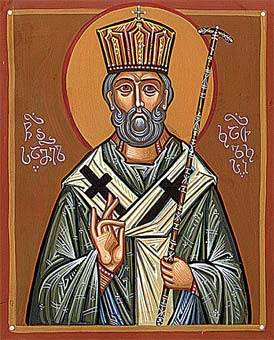|
|
The Holy Apostle Andrew the First-Called He was the son of Jonah and brother of Peter, born in Bethsaida and a fisherman by profession. He was first a disciple of St John the Baptist, but, when John pointed to the Lord Jesus and said: "Behold the Lamb of God" (Jn. 1:36), St Andrew left his first teacher and followed Christ. After that, Andrew brought his brother Peter to the Lord. After the descent of the Holy Spirit, it fell to the lot of the first of Christ"s apostles, St Andrew, to preach the Gospel in Byzantium and Thrace, then in the lands along the Danube, in Russia and around the Black Sea, and finally in Epirus, Greece and the Peloponnese, where he suffered. In Byzantium, he installed St Stachys as its first bishop; in Kiev he raised the Cross on high and prophesied a Christian future for the Russian people; in Thrace, Epirus, Greece and the Peloponnese, he brought many people to the Faith and gave them bishops and priests. In the city of Patras he performed many wonders in the name of Christ and brought many to the Lord, among whom were the brother and wife of the imperial governor, Aegeatus. Aegeatus, infuriated by this, put Andrew to torture and then crucified him. While he was still alive on the cross, the Apostle of Christ taught the Christians who were gathered round him. The people wanted to take him down from the cross, but he would not let them. Finally, the Apostle prayed to God and a strange radiance surrounded him. This light lasted for half an hour and, when it disappeared, the Apostle gave his holy soul into God"s hands. Thus the first-called Apostle, who first of the twelve Great Apostles came to know the Lord and followed Him, finished his earthly course. St Andrew suffered for his Lord in the year 62. His relics were translated to Constantinople, but his head was later taken to Rome and one hand to Moscow. He was the son of Jonah and brother of Peter, born in Bethsaida and a fisherman by profession. He was first a disciple of St John the Baptist, but, when John pointed to the Lord Jesus and said: "Behold the Lamb of God" (Jn. 1:36), St Andrew left his first teacher and followed Christ. After that, Andrew brought his brother Peter to the Lord. After the descent of the Holy Spirit, it fell to the lot of the first of Christ"s apostles, St Andrew, to preach the Gospel in Byzantium and Thrace, then in the lands along the Danube, in Russia and around the Black Sea, and finally in Epirus, Greece and the Peloponnese, where he suffered. In Byzantium, he installed St Stachys as its first bishop; in Kiev he raised the Cross on high and prophesied a Christian future for the Russian people; in Thrace, Epirus, Greece and the Peloponnese, he brought many people to the Faith and gave them bishops and priests. In the city of Patras he performed many wonders in the name of Christ and brought many to the Lord, among whom were the brother and wife of the imperial governor, Aegeatus. Aegeatus, infuriated by this, put Andrew to torture and then crucified him. While he was still alive on the cross, the Apostle of Christ taught the Christians who were gathered round him. The people wanted to take him down from the cross, but he would not let them. Finally, the Apostle prayed to God and a strange radiance surrounded him. This light lasted for half an hour and, when it disappeared, the Apostle gave his holy soul into God"s hands. Thus the first-called Apostle, who first of the twelve Great Apostles came to know the Lord and followed Him, finished his earthly course. St Andrew suffered for his Lord in the year 62. His relics were translated to Constantinople, but his head was later taken to Rome and one hand to Moscow.St Frumentius, the Enlightener of AbyssiniaIn the time of the Emperor Constantine the Great, a learned man from Tyre called Meropius travelled to India. He took with him two young Christians, brothers called Edessius and Frumentius. On the journey, the ship foundered in a storm on the Abyssinian coast, and the wild Abyssinians killed all the people from the ship except these two brothers, Edessius and Frumentius. They lived in Abyssinia for several years and succeeded in entering the service of the king. Frumentius began to preach the Christian faith, at first fairly cautiously, and became convinced that the land was ripe for such preaching. The two brothers then took ship, Edessius to Tyre to his parents and Frumentius to Alexandria, to Patriarch Athanasius the Great. Frumentius described the situation in Abyssinia to the Patriarch and sought pastors to bring the people to the Faith. St Athanasius consecrated Frumentius bishop, and he returned to Abyssinia where, by his zeal and his miracles, he brought the whole of Abyssinia to the Faith during his lifetime. This great pastor of Christ"s flock and enlightener of Abyssinia died peacefully in the year 370, and entered into the Kingdom of his Lord.
St. Alexander, bishop of Methymna on Lesbos
St. Vakhtang Gorgasali, King of Georgia (502) The holy and right-believing king Vakhtang I ascended the throne of Kartli at the age of fifteen. At that time Kartli was continually being invaded by the Persians from the south and by the Ossetians from the north. The situation was no better in western Georgia: the Byzantines had captured all the lands from Egrisi to Tsikhegoji... The holy and right-believing king Vakhtang I ascended the throne of Kartli at the age of fifteen. At that time Kartli was continually being invaded by the Persians from the south and by the Ossetians from the north. The situation was no better in western Georgia: the Byzantines had captured all the lands from Egrisi to Tsikhegoji...Hierarch Peter, First Catholicos of Georgia Saint Peter was the first catholicos of Georgia. He led the Church of Kartli from the 460s through the beginning of the 6th century. According to God’s will, St. Peter inaugurated the dynasty of the chief shepherds of Georgia... Saint Peter was the first catholicos of Georgia. He led the Church of Kartli from the 460s through the beginning of the 6th century. According to God’s will, St. Peter inaugurated the dynasty of the chief shepherds of Georgia...Hierarch Samuel, Second Catholicos of Georgia St. Samuel ascended the throne of the Apostolic Orthodox Church of Georgia in the 6th century, after the holy catholicos Peter. Like St. Peter, Samuel was a native of Byzantium. He arrived with Catholicos Peter in Georgia as a bishop, at the invitation of King Vakhtang Gorgasali and with the blessing of the patriarch of Constantinople... St. Samuel ascended the throne of the Apostolic Orthodox Church of Georgia in the 6th century, after the holy catholicos Peter. Like St. Peter, Samuel was a native of Byzantium. He arrived with Catholicos Peter in Georgia as a bishop, at the invitation of King Vakhtang Gorgasali and with the blessing of the patriarch of Constantinople... |